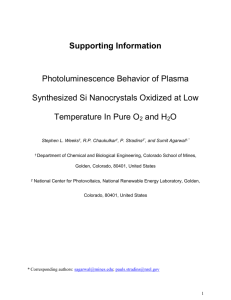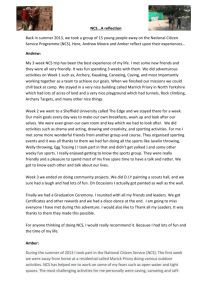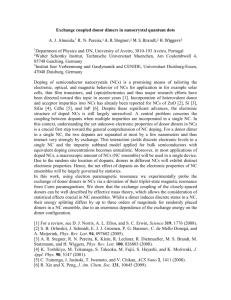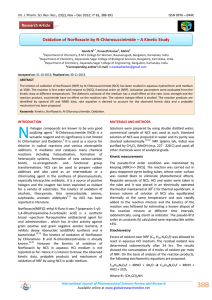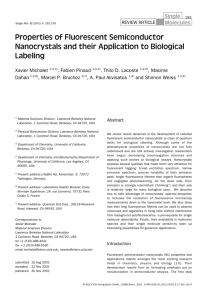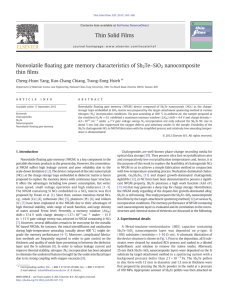Novikau et al. Nanoscale Research Letters 2011, 6:148 http://www
advertisement
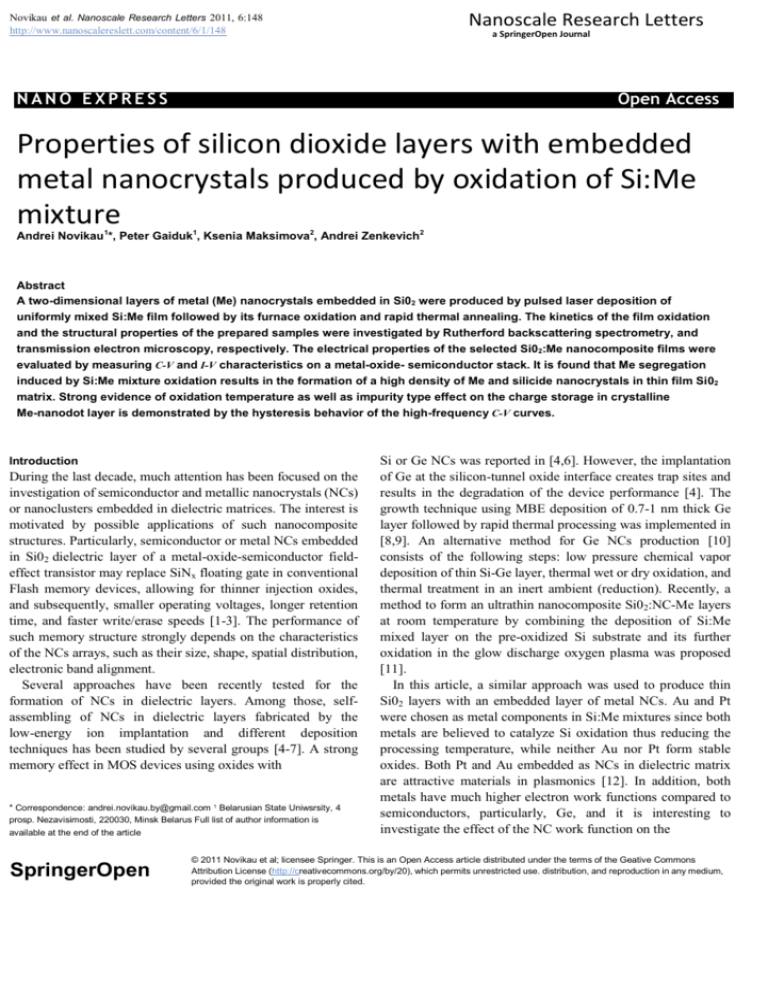
Nanoscale Research Letters Novikau et al. Nanoscale Research Letters 2011, 6:148 http://www.nanoscalereslett.com/content/6/1/148 a SpringerOpen Journal NANO EXPRESS Open Access Properties of silicon dioxide layers with embedded metal nanocrystals produced by oxidation of Si:Me mixture Andrei Novikau1*, Peter Gaiduk1, Ksenia Maksimova2, Andrei Zenkevich2 Abstract A two-dimensional layers of metal (Me) nanocrystals embedded in Si02 were produced by pulsed laser deposition of uniformly mixed Si:Me film followed by its furnace oxidation and rapid thermal annealing. The kinetics of the film oxidation and the structural properties of the prepared samples were investigated by Rutherford backscattering spectrometry, and transmission electron microscopy, respectively. The electrical properties of the selected Si02:Me nanocomposite films were evaluated by measuring C-V and I-V characteristics on a metal-oxide- semiconductor stack. It is found that Me segregation induced by Si:Me mixture oxidation results in the formation of a high density of Me and silicide nanocrystals in thin film Si02 matrix. Strong evidence of oxidation temperature as well as impurity type effect on the charge storage in crystalline Me-nanodot layer is demonstrated by the hysteresis behavior of the high-frequency C-V curves. Introduction During the last decade, much attention has been focused on the investigation of semiconductor and metallic nanocrystals (NCs) or nanoclusters embedded in dielectric matrices. The interest is motivated by possible applications of such nanocomposite structures. Particularly, semiconductor or metal NCs embedded in Si02 dielectric layer of a metal-oxide-semiconductor fieldeffect transistor may replace SiNx floating gate in conventional Flash memory devices, allowing for thinner injection oxides, and subsequently, smaller operating voltages, longer retention time, and faster write/erase speeds [1-3]. The performance of such memory structure strongly depends on the characteristics of the NCs arrays, such as their size, shape, spatial distribution, electronic band alignment. Several approaches have been recently tested for the formation of NCs in dielectric layers. Among those, selfassembling of NCs in dielectric layers fabricated by the low-energy ion implantation and different deposition techniques has been studied by several groups [4-7]. A strong memory effect in MOS devices using oxides with * Correspondence: andrei.novikau.by@gmail.com 1 Belarusian State Uniwsrsity, 4 prosp. Nezavisimosti, 220030, Minsk Belarus Full list of author information is available at the end of the article SpringerOpen Si or Ge NCs was reported in [4,6]. However, the implantation of Ge at the silicon-tunnel oxide interface creates trap sites and results in the degradation of the device performance [4]. The growth technique using MBE deposition of 0.7-1 nm thick Ge layer followed by rapid thermal processing was implemented in [8,9]. An alternative method for Ge NCs production [10] consists of the following steps: low pressure chemical vapor deposition of thin Si-Ge layer, thermal wet or dry oxidation, and thermal treatment in an inert ambient (reduction). Recently, a method to form an ultrathin nanocomposite Si02:NC-Me layers at room temperature by combining the deposition of Si:Me mixed layer on the pre-oxidized Si substrate and its further oxidation in the glow discharge oxygen plasma was proposed [11]. In this article, a similar approach was used to produce thin Si02 layers with an embedded layer of metal NCs. Au and Pt were chosen as metal components in Si:Me mixtures since both metals are believed to catalyze Si oxidation thus reducing the processing temperature, while neither Au nor Pt form stable oxides. Both Pt and Au embedded as NCs in dielectric matrix are attractive materials in plasmonics [12]. In addition, both metals have much higher electron work functions compared to semiconductors, particularly, Ge, and it is interesting to investigate the effect of the NC work function on the © 2011 Novikau et al; licensee Springer. This is an Open Access article distributed under the terms of the Geative Commons Attribution License (http://creativecommons.org/by/20), which permits unrestricted use. distribution, and reproduction in any medium, provided the original work is properly cited.
